
Nevsky Prospect is the main street in the federal city of St. Petersburg in Russia. It takes its name from the Alexander Nevsky Lavra, the monastery which stands at the eastern end of the street, and which in turn commemorates the Russian hero Prince Saint Alexander Nevsky (1221–1263). Following his founding of Saint Petersburg in 1703, Tsar Peter I planned the course of the street as the beginning of the road to Novgorod and Moscow. The avenue runs from the Admiralty in the west to the Moscow Railway Station and, after veering slightly southwards at Vosstaniya Square, to the Alexander Nevsky Lavra.
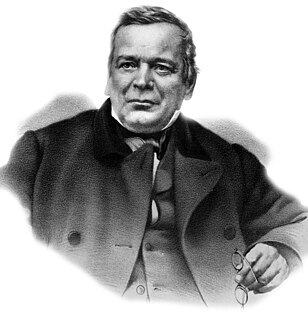
Konstantin Andreyevich Thon, also spelled Ton was an official architect of Imperial Russia during the reign of Nicholas I. His major works include the Cathedral of Christ the Saviour, the Grand Kremlin Palace and the Kremlin Armoury in Moscow.

Saint Alexander Nevsky Lavra or Saint Alexander Nevsky Monastery was founded by Peter I of Russia in 1710 at the eastern end of the Nevsky Prospekt in Saint Petersburg supposing that that was the site of the Neva Battle in 1240 when Alexander Nevsky, a prince, defeated the Swedes; however, the battle actually took place about 12 miles (19 km) away from that site. "On April 5, 1713, in St. Petersburg, in the presence of Peter I, the wooden Church of the Annunciation was consecrated. This day is considered the official founding date of the Alexander Nevsky Lavra."

Kazan Cathedral or Kazanskiy Kafedralniy Sobor, also known as the Cathedral of Our Lady of Kazan, is a cathedral of the Russian Orthodox Church on the Nevsky Prospekt in Saint Petersburg. It is dedicated to Our Lady of Kazan, one of the most venerated icons in Russia.
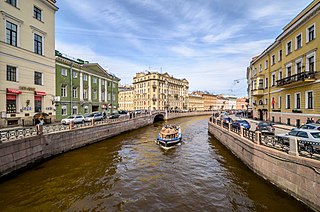
The Moyka is a secondary, in comparison with the Neva, river in Saint Petersburg that encircles the central portion of the city, effectively making it an island or a group of islands together with the Neva, Fontanka, Griboyedov Canal and shorter canals like Kryukov. The river, originally known as Mya, derives its name from the Ingrian word Muya for "slush" or "mire", having its original source in former swamp. It is 5 kilometres (3 mi) long and 40 metres (130 ft) wide.
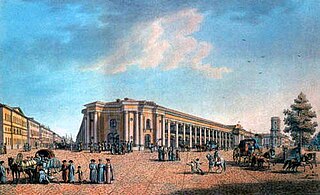
Great Gostiny Dvor is a vast department store on Nevsky Avenue in St Petersburg.

Beloselsky Belozersky Palace is a Neo-Baroque palace at the intersection of the Fontanka River and Nevsky Prospekt in Saint Petersburg, Russia.

Ligovsky Prospekt is a major street in Saint Petersburg. Before the establishment of the city, it was a street leading to Novgorod, used by the people living in the villages around the delta of Neva.
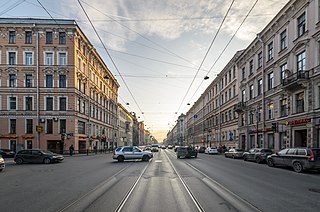
Liteyny Avenue is a wide avenue in the Central District of Saint Petersburg, Russia. The avenue runs from Liteyny Bridge to Nevsky Avenue.
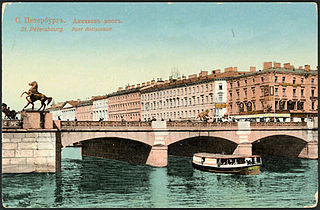
The Anichkov Bridge is the oldest and most famous bridge across the Fontanka River in Saint Petersburg, Russia. The current bridge, built in 1841-42 and reconstructed in 1906-08, combines a simple form with some spectacular decorations. As well as its four famous horse sculptures (1849–50), the bridge has some of the most celebrated ornate iron railings in Saint Petersburg. The structure is mentioned in the works of Pushkin, Gogol, and Dostoevsky.

The Anichkov Palace, a former imperial palace in Saint Petersburg, stands at the intersection of Nevsky Avenue and the Fontanka River.
The appearance of St. Petersburg includes long, straight boulevards, vast spaces, gardens and parks, decorative wrought-iron fences, monuments and decorative sculptures. The Neva River itself, together with its many canals and their granite embankments and bridges help to give the city its particular ambience.

Voznesensky Prospekt is a 1.8 km long street in Admiralteysky District of Saint Petersburg, Russia. Crossing Saint Isaac's Square, the Moika and Griboyedov Canal, the street spans from Admiralteysky Prospekt to Izmaylovsky Bridge across Fontanka, where it turns into Izmaylovsky Prospekt. According to the city plan of 1737, the center of Saint Petersburg should develop along three radial axes meeting at the Admiralty's spire: Nevsky Prospekt, Gorokhovaya Street and Voznesensky Prospekt. In 1923-1991 the street was named Mayorov Prospekt after a prominent Bolshevik killed in the Russian Civil War.

The Evangelical Lutheran Church of Saint Mary is an Evangelical Lutheran church located in Saint Petersburg, Russia. It was built in 1805 and refurbished in 2002. Its address is: Bolshaya Konyushennnaya Ulitsa 8A, off Nevsky Prospekt. It is usually called the Finnish church and is one of the oldest and largest Protestant churches in Russia.

The Evangelical Lutheran Church of Saint Catherine is an Evangelical Lutheran church located at Malaya Konyushnaya Ulitsa 1 in Saint Petersburg, Russia. The building was built in 1885. As it was built by and for Swedish expatriates in Saint Petersburg, it is usually called the Swedish church. The adjacent building is occupied by the Swedish General Consulate.

Krasny Prospekt or Krasny Avenue is the central street and major thoroughfare in the city of Novosibirsk, Russia. Its length is about 7 km. It runs across the central part of the city starting from the right bank of the Ob River and terminates in the vicinity of Severny Airport. The main square of Novosibirsk - Lenin Square - is a part of Krasny prospekt, as well as Sverdlov and Kalinin squares.
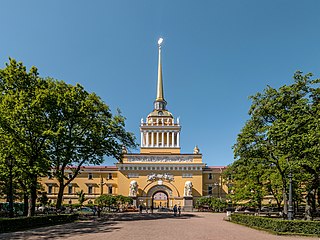
The Admiralty Building is the former headquarters of the Admiralty Board and the Imperial Russian Navy in Central St. Petersburg, Russia and the current headquarters of the Russian Navy.

The following outline is provided as an overview of and topical guide to Saint Petersburg:

Alexander Nevsky Square, formerly called Red Square, is a city square in Tsentralny District, Saint Petersburg. It is at the east end of Nevsky Prospekt, linking the street with the Alexander Nevsky Lavra.
Антонов П. А. Городская дума на Невском // Диалог. 1989. № 31. С. 21-26.






















